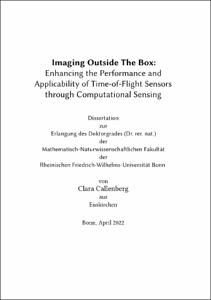Callenberg, Clara: Imaging Outside The Box : Enhancing the Performance and Applicability of Time-of-Flight Sensors through Computational Sensing. - Bonn, 2022. - Dissertation, Rheinische Friedrich-Wilhelms-Universität Bonn.
Online-Ausgabe in bonndoc: https://nbn-resolving.org/urn:nbn:de:hbz:5-69055
Online-Ausgabe in bonndoc: https://nbn-resolving.org/urn:nbn:de:hbz:5-69055
@phdthesis{handle:20.500.11811/10516,
urn: https://nbn-resolving.org/urn:nbn:de:hbz:5-69055,
author = {{Clara Callenberg}},
title = {Imaging Outside The Box : Enhancing the Performance and Applicability of Time-of-Flight Sensors through Computational Sensing},
school = {Rheinische Friedrich-Wilhelms-Universität Bonn},
year = 2022,
month = dec,
note = {Time-of-Flight (ToF) imaging, which allows to measure the time that light has taken to travel from a light source to a camera, is an increasingly relevant sensing modality. ToF imagers are used, for example, in smartphones, cars, virtual and augmented reality hardware and robotics, where they usually serve as depth sensors that allow to capture the shape of a three-dimensional scene or environment. This thesis explores two types of ToF imagers -- Amplitude-Modulated Continuous-Wave (AMCW) imagers and Single-Photon Avalanche Diode (SPAD) imagers -- and their capabilities to go beyond their designated and conventional purpose or use cases.
Multiple general difference imaging applications are demonstrated using AMCW imaging systems by coupling different types of active light sources with the ToF sensor and employing specific modulation signal patterns. Those applications include spatial and temporal gradient imaging, direct-global separation, bipolar color-matching functions and depth edge detection. Due to the implementation in AMCW ToF hardware, the difference images can be recorded in a single shot, and the difference between the two signals is taken during the exposure, effectively eliminating alignment issues in dynamic scenes and improving noise characteristics.
The spatial resolution of time-resolved SPAD image data is increased by computational sensor fusion with a CCD camera. An experimental setup using a single objective lens and beam splitter to image the same scene on both types of sensors is employed and a computational light transport model is presented that allows to reconstruct a full high-spatial-resolution transient image for LIDAR and FLIM applications.
Finally, a very low-cost and low-resolution SPAD sensor device that is commonly used in smartphones as proximity sensors, is used to demonstrate challenging computer vision tasks: depth imaging, material classification, and tracking of an object's position that is not in the direct line of sight of the sensor.},
url = {https://hdl.handle.net/20.500.11811/10516}
}
urn: https://nbn-resolving.org/urn:nbn:de:hbz:5-69055,
author = {{Clara Callenberg}},
title = {Imaging Outside The Box : Enhancing the Performance and Applicability of Time-of-Flight Sensors through Computational Sensing},
school = {Rheinische Friedrich-Wilhelms-Universität Bonn},
year = 2022,
month = dec,
note = {Time-of-Flight (ToF) imaging, which allows to measure the time that light has taken to travel from a light source to a camera, is an increasingly relevant sensing modality. ToF imagers are used, for example, in smartphones, cars, virtual and augmented reality hardware and robotics, where they usually serve as depth sensors that allow to capture the shape of a three-dimensional scene or environment. This thesis explores two types of ToF imagers -- Amplitude-Modulated Continuous-Wave (AMCW) imagers and Single-Photon Avalanche Diode (SPAD) imagers -- and their capabilities to go beyond their designated and conventional purpose or use cases.
Multiple general difference imaging applications are demonstrated using AMCW imaging systems by coupling different types of active light sources with the ToF sensor and employing specific modulation signal patterns. Those applications include spatial and temporal gradient imaging, direct-global separation, bipolar color-matching functions and depth edge detection. Due to the implementation in AMCW ToF hardware, the difference images can be recorded in a single shot, and the difference between the two signals is taken during the exposure, effectively eliminating alignment issues in dynamic scenes and improving noise characteristics.
The spatial resolution of time-resolved SPAD image data is increased by computational sensor fusion with a CCD camera. An experimental setup using a single objective lens and beam splitter to image the same scene on both types of sensors is employed and a computational light transport model is presented that allows to reconstruct a full high-spatial-resolution transient image for LIDAR and FLIM applications.
Finally, a very low-cost and low-resolution SPAD sensor device that is commonly used in smartphones as proximity sensors, is used to demonstrate challenging computer vision tasks: depth imaging, material classification, and tracking of an object's position that is not in the direct line of sight of the sensor.},
url = {https://hdl.handle.net/20.500.11811/10516}
}






